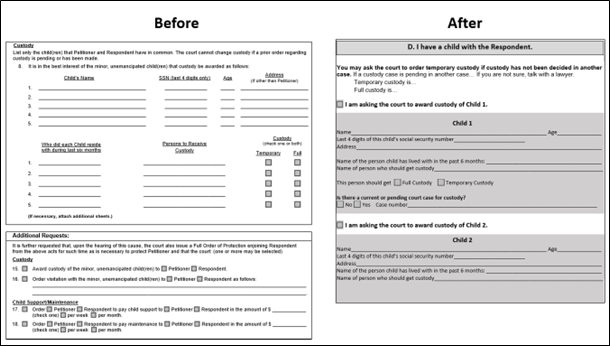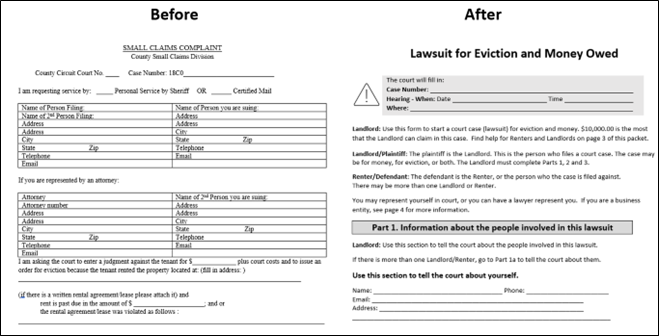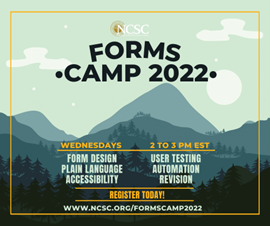June 14, 2023
Standardized court forms are an important tool that helps increase access to justice for self-represented litigants (SRLs). Court forms help litigants file paperwork that is legally sufficient. Unfortunately, court forms are usually not drafted with the user in mind.
– Winter Forms Camp participant |
NCSC created Forms Camp to bring participants from across the country together to improve state court forms. Supported by the Pew Charitable Trust's Civil Legal System Modernization Project, 3,400 attended the virtual sessions.
“Lots of great info and tips presented in a very easy to understand and organized manner.” – Forms Camp participant |
“We want to have stellar forms that are easy to understand and use.” – Winter Forms Camp participant |
So, what lessons can we share?
- Write in plain language. Be clear and concise. The reader should be able to understand the form the first time they read it.
- Organize information into bite-sized chunks. Information overload impedes understanding. Break down complex processes into steps. Use URLs and QR codes to connect people to more information when they are ready.
Arrange questions in a logical order. Group similar questions together. Don’t skip around!

Don’t repeat questions. Asking a litigant to repeat the same information does not respect their time and can be triggering to individuals who have experienced trauma.
Use design to engage users. Use headings, icons, and white space to keep the reader's attention.

User test forms. User testing helps catch mistakes early, prevents confused litigants, and saves staff time. Just 5 users will catch most issues.
Bury insider information. Insider information is citations or other information for court staff and others in the legal system. Use the prime space at the top of the page to grab the reader’s attention with the most important information.

Eliminate gendered terms. For example, use “parents,” not “mother and father.” Learn more, and use free tools to find and replace terms that are not inclusive.
Make sure forms are accessible. Consider the needs of all form users, including individuals with disabilities and limited English proficiency.
Just do it. Don’t be paralyzed by perfection. Even small changes can drastically improve user experience.
|
Want to learn more? NCSC offers free training, technical assistance, and information. Connect with Lonni Summers at lsummers@ncsc.org. Follow the National Center for State Courts on Facebook, Twitter, and LinkedIn.

 … our forms were written by lawyers for lawyers. Many…have not been updated in over a decade. Even those who work in the legal system have a hard time understanding…the language in our forms.”
… our forms were written by lawyers for lawyers. Many…have not been updated in over a decade. Even those who work in the legal system have a hard time understanding…the language in our forms.”  Summer Forms Camp offered 9 hours of free training and support on topics including plain language, form design, accessibility, automation, and user testing.
Summer Forms Camp offered 9 hours of free training and support on topics including plain language, form design, accessibility, automation, and user testing. Winter Forms Camp offered intensive technical assistance to 6 cohorts. Participants revised forms, translating content into plain language and incorporating design principles. Then, they user tested their forms.
Winter Forms Camp offered intensive technical assistance to 6 cohorts. Participants revised forms, translating content into plain language and incorporating design principles. Then, they user tested their forms.